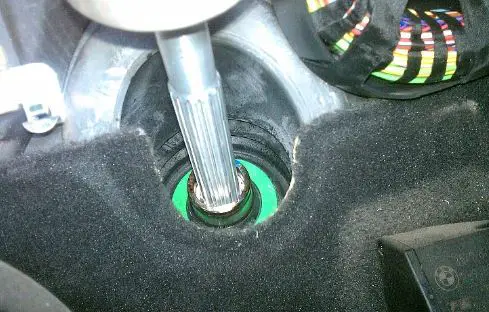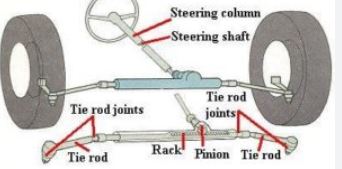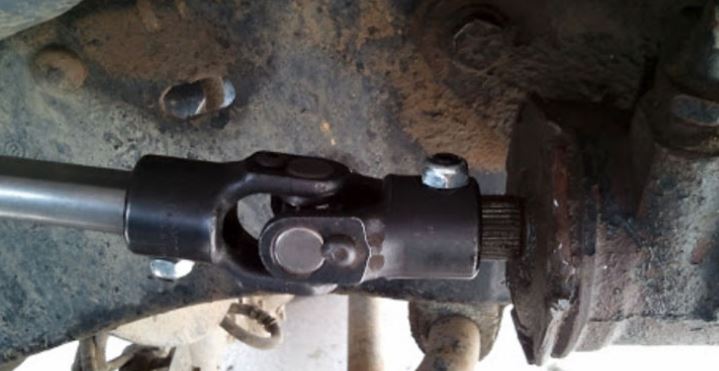The steering column is an essential component of a vehicle’s steering system, which connects the steering wheel to the steering gear. It is responsible for transferring the driver’s input from the steering wheel to the wheels of the vehicle, allowing for easy and smooth maneuvering. However, like any other mechanical part, the steering column requires regular maintenance to function correctly. One critical aspect of maintenance is lubrication, which involves applying a lubricant to the steering to reduce friction and wear between its moving parts.
In this , we will explore the steps involved in lubricating the steering column of a vehicle. We will discuss the importance of lubrication and the types of lubricants suitable for the steering and we will provide a step-by-step guide on how to lubricate steering column.
Signs That Your Steering Column Needs Lubrication

- Stiff or Hard-to-Turn Steering Wheel: One of the most apparent signs that your steering column needs lubrication is a stiff or hard-to-turn steering wheel. This is usually caused by excessive friction between the steering moving parts, making it difficult to turn the steering wheel smoothly.
- Squeaking or Grinding Sounds: When you hear squeaking or grinding sounds when turning the steering wheel, it could indicate that the steering column needs lubrication. These sounds are usually caused by the lack of lubrication on the steering moving parts.
- Vibration in the Steering Wheel: A vibration in the steering wheel could indicate that the steering column’s moving parts are not working correctly. This could be caused by friction or wear and tear on the steering, which can be prevented by lubricating the steering regularly.
- Loose or Wobbly Steering Wheel: A loose or wobbly steering wheel could also be a sign that the steering column needs lubrication. This could be caused by excessive wear and tear on the steering moving parts, which can be prevented by lubricating the steering regularly.
- Reduced Responsiveness: If your vehicle’s steering is not as responsive as it used to be, it could be a sign that the steering needs lubrication. Lubricating the steering can help reduce friction, ensuring that the steering system responds promptly and smoothly.
Tools and Materials Required
In order to lubricate your steering column, you’ll need a few tools and materials.
Tools:
- Socket wrench
- Pliers
- Ratchet
- Screwdriver
- Clean rags
- Rubber gloves
Lubricants:
- White lithium grease
- Silicone spray lubricant
- Multi-purpose grease
Preparation Before Lubricating the Steering Column
- Park the Vehicle on a Level Surface: Before starting any maintenance work on a vehicle, it is essential to park it on a flat surface. This will ensure that the vehicle is stable and won’t roll or move during the lubrication process.
- Turn off the Engine: To avoid any accidents, it is essential to turn off the engine before starting the lubrication process. This will ensure that the steering wheel is locked in place, and you won’t accidentally turn the wheel while working on the steering.
- Let the Engine Cool: If you have been driving the vehicle recently, it is essential to let the engine cool down before starting the lubrication process. This will prevent any burns or injuries that may result from working on a hot engine.
- Wear Protective Gear: When working on a vehicle, it is crucial to wear protective gear, such as gloves and safety goggles. This will protect your hands and eyes from any grease or dirt that may come into contact with them during the lubrication process.
- Gather Lubrication Supplies: Finally, gather all the necessary lubrication supplies, including the appropriate lubricant for the steering, a clean rag or cloth, and a lubrication tool such as a spray can or a grease gun. Make sure that the lubricant is recommended by the vehicle’s manufacturer and is suitable for the steering.
How to Lubricate Steering Column: Step-by-step

- Gather the necessary tools: Before you start, you will need to gather the necessary tools. These may include a lubricant (such as silicone spray or white lithium grease), a rag, and a flashlight.
- Locate the steering column: The steering is located beneath the dashboard and connects the steering wheel to the steering gear. You may need to use the flashlight to locate it.
- Clean the steering column: Before applying the lubricant, it is essential to clean the surfaces to ensure that the lubricant adheres correctly. Use a rag to wipe away any dirt or debris on the steering.
- Apply the lubricant: Once the steering column is clean, apply the lubricant to the various moving parts of the column. Be sure to follow the manufacturer’s instructions on how to apply the lubricant properly.
- Work the steering wheel: After applying the lubricant, turn the steering wheel from left to right a few times to distribute the lubricant evenly.
- Wipe off any excess lubricant: Use the rag to wipe off any excess lubricant from the steering column.
- Test the steering system: Finally, test the steering system to ensure that it operates smoothly and efficiently. Turn the steering wheel from left to right and listen for any unusual sounds or resistance.
Common Mistakes to Avoid While Lubricating the Steering Column
- Using the wrong type of lubricant: Using the wrong type of lubricant can cause damage to the steering column, resulting in reduced performance and even failure. It is essential to use the right type of lubricant recommended by the manufacturer to ensure optimal performance and prevent damage to the steering.
- Over-lubrication: Applying too much lubricant to the steering column can cause it to accumulate in areas where it is not needed, leading to a build-up of debris and dirt. This build-up can cause increased friction, leading to damage to the steering.
- Insufficient lubrication: Applying too little lubricant to the steering column can cause it to wear out more quickly, resulting in poor performance and steering difficulties.
- Neglecting other parts of the steering system: While lubricating the steering column is essential, neglecting other parts of the steering system can lead to issues and reduced performance. It is essential to inspect and lubricate all parts of the steering system as recommended by the manufacturer.
- Not following the manufacturer’s instructions: Each vehicle has specific requirements for lubricating the steering column. It is crucial to read and follow the manufacturer’s instructions carefully to ensure optimal performance and avoid damage to the steering system.
Testing Your Steering Column After Lubrication

Start the engine and let it idle. Turn the steering wheel left and right, listening for any unusual noises. The steering wheel should move smoothly without any binding or grinding sounds.
While still idling, turn the steering wheel all the way to the left and hold it for a few seconds. Then, turn the steering wheel all the way to the right and hold it for a few seconds. The steering wheel should move smoothly and return to the center position without any delay.
Take your vehicle for a test drive, ensuring that you drive on both straight and curved roads. Test the steering wheel’s responsiveness, making sure it turns easily and smoothly without any unusual noises or vibrations.
Test the alignment of your vehicle by driving on a straight and level road, ensuring that the steering wheel is centered and the vehicle is not drifting to the left or right.
If you notice any problems or unusual noises during the test, inspect the steering column and re-lubricate it as needed. It may also be necessary to take your vehicle to a professional mechanic for further inspection and repairs.
When to Seek Professional Help

- Unusual Noises: If you notice any unusual noises coming from your vehicle, it’s a sign that something is wrong. Grinding, screeching, or knocking sounds may indicate a problem with your steering system, brakes, or suspension. Ignoring these noises can lead to more significant issues and even put your safety at risk.
- Warning Lights: Most modern vehicles are equipped with warning lights that indicate when something is wrong. If you notice any warning lights on your dashboard, it’s time to take your car to a professional mechanic. Ignoring these lights can cause serious damage to your vehicle and even lead to an accident.
- Fluid Leaks: Leaking fluids, such as oil, coolant, or brake fluid, can be a sign of a serious problem. These leaks can damage your engine or transmission and even cause a fire hazard. If you notice any fluid leaks, it’s best to seek professional help immediately.
- Electrical Problems: Modern vehicles are equipped with a complex electrical system that controls everything from the radio to the engine. If you’re experiencing any electrical problems, such as flickering lights or a dead battery, it’s best to take your car to a professional mechanic. Attempting to fix electrical issues without proper training can be dangerous and can cause more significant problems.
- Performance Issues: If your vehicle is experiencing performance issues, such as reduced power or poor fuel economy, it’s time to seek professional help. These issues can be caused by a variety of factors, such as a clogged air filter or a malfunctioning sensor. A professional mechanic can diagnose the problem and provide the necessary repairs.
Maintenance Tips for Your Steering Column
- Regular Inspection: Regularly inspect the steering column for any signs of damage or wear. Check for cracks, dents, or any other visible damage. Also, check the steering connections, including the universal joint, and ensure they are tight and secure.
- Lubrication: The steering column’s moving parts require proper lubrication to reduce friction and wear. Apply a suitable lubricant, such as white lithium grease or silicone lubricant, to the steering joints and connections.
- Keep It Clean: Dirt and debris can accumulate on the steering column over time, causing wear and tear. Clean the steering regularly with a soft cloth and a mild cleaning solution to remove any dirt or grime.
- Avoid Overloading: Overloading the steering column can cause significant damage. Avoid hanging heavy items such as bags, coats, or other items on the steering or the steering wheel.
- Proper Handling: Be careful when handling the steering wheel, especially when turning it sharply. Avoid turning the steering wheel when the vehicle is stationary, as this can cause excessive wear on the steering.
FAQs About How to Lubricate Steering Column
Can I use any type of lubricant to lubricate my steering column?
No, you cannot use just any type of lubricant to lubricate your steering column. It is important to use a lubricant that is specifically designed for your column. White lithium grease is a popular choice, but you can also use silicone spray lubricant or multi-purpose grease. Be sure to consult your vehicle’s owner’s manual or a mechanic if you are unsure which lubricant to use.
How long does the lubrication last?
The duration of the lubrication will depend on several factors, including the type of lubricant you used, how frequently you use your vehicle, and the weather conditions in your area. In general, you can expect the lubrication to last for several months.
What should I do if I accidentally apply too much lubricant?
If you accidentally apply too much lubricant, you can wipe off the excess with a clean rag. It’s important to avoid over-lubricating your steering as this can cause damage.
Final Thought
In the end, knowing how to lubricate your steering column is an important skill for any car owner or driver. By following the steps outlined in this article, you can help ensure that your vehicle’s steering operates smoothly and safely. Regularly lubricating your column can also help extend its lifespan and prevent potential issues from occurring.
Remember to use the right type of lubricant for your steering column and to avoid over-lubricating. If you encounter any issues during the process or are unsure about how to proceed, it’s always a good idea to seek the advice of a professional mechanic.
Related Topic:
- Is Red and Tacky Grease Good for Wheel Bearings
- How Often Should You Grease Wheel Bearings on a Car
- Can You Over Grease Wheel Bearings
- Can You Use Moly Grease in Wheel Bearings
- How to Grease Trailer Bearings With Grease Gun
- Can You Lubricate Timing Belt
- How to Lubricate Steering Column
- How to Lubricate Sliding Windows
- How Do Automatic Lubrication Systems Work


